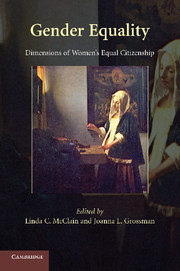Book contents
- Frontmatter
- Contents
- Contributors
- Acknowledgments
- Gender Equality
- Introduction
- PART I CONSTITUTIONAL CITIZENSHIP AND GENDER
- PART II POLITICAL CITIZENSHIP AND GENDER
- PART III SOCIAL CITIZENSHIP AND GENDER
- PART IV SEXUAL AND REPRODUCTIVE CITIZENSHIP
- PART V GLOBAL CITIZENSHIP AND GENDER
- 17 Women's Unequal Citizenship at the Border: Lessons From Three Nonfiction Films About the Women of Juárez
- 18 Domestic Violence, Citizenship, and Equality
- 19 On the Path to Equal Citizenship and Gender Equality: Political, Judicial, and Legal Empowerment of Muslim Women
- 20 Gender and Human Rights: Between Morals and Politics
- Suggested Readings
- Index
- References
18 - Domestic Violence, Citizenship, and Equality
Published online by Cambridge University Press: 05 August 2012
- Frontmatter
- Contents
- Contributors
- Acknowledgments
- Gender Equality
- Introduction
- PART I CONSTITUTIONAL CITIZENSHIP AND GENDER
- PART II POLITICAL CITIZENSHIP AND GENDER
- PART III SOCIAL CITIZENSHIP AND GENDER
- PART IV SEXUAL AND REPRODUCTIVE CITIZENSHIP
- PART V GLOBAL CITIZENSHIP AND GENDER
- 17 Women's Unequal Citizenship at the Border: Lessons From Three Nonfiction Films About the Women of Juárez
- 18 Domestic Violence, Citizenship, and Equality
- 19 On the Path to Equal Citizenship and Gender Equality: Political, Judicial, and Legal Empowerment of Muslim Women
- 20 Gender and Human Rights: Between Morals and Politics
- Suggested Readings
- Index
- References
Summary
During the last decades, there has been no aspect of women's rights in which there has been as much dramatic change as in the law of domestic violence. Fifty years ago, for example, domestic violence was not even recognized as a subject of study or as a legal problem – it was simply invisible. Marriage – the notion that husband and wife were one and that one was the husband – made domestic violence permissible and acceptable.
Today, intimate violence is recognized as a serious harm – a harm within intimate relationships that has an impact on every aspect of the law, from criminal law to torts, reproductive rights, civil rights, employment law, and international human rights, and especially family law. But we have also begun to recognize that intimate violence has profound consequences for women's right to full citizenship and equality and women's right to work, to economic independence, and to health, not only in this country, but around the world. Recognition of the international human rights dimensions of intimate violence is a first step to appreciation of global citizenship.
In this chapter, I briefly highlight some of the ways in which violence affects women's equality and citizenship. I first examine the tremendous changes in recognition of the problem and pervasiveness of intimate violence both in the United States and around the world. Given the profound nature of these changes, I only touch on themes that I have discussed more fully elsewhere.
- Type
- Chapter
- Information
- Gender EqualityDimensions of Women's Equal Citizenship, pp. 378 - 389Publisher: Cambridge University PressPrint publication year: 2009
References
- 1
- Cited by

